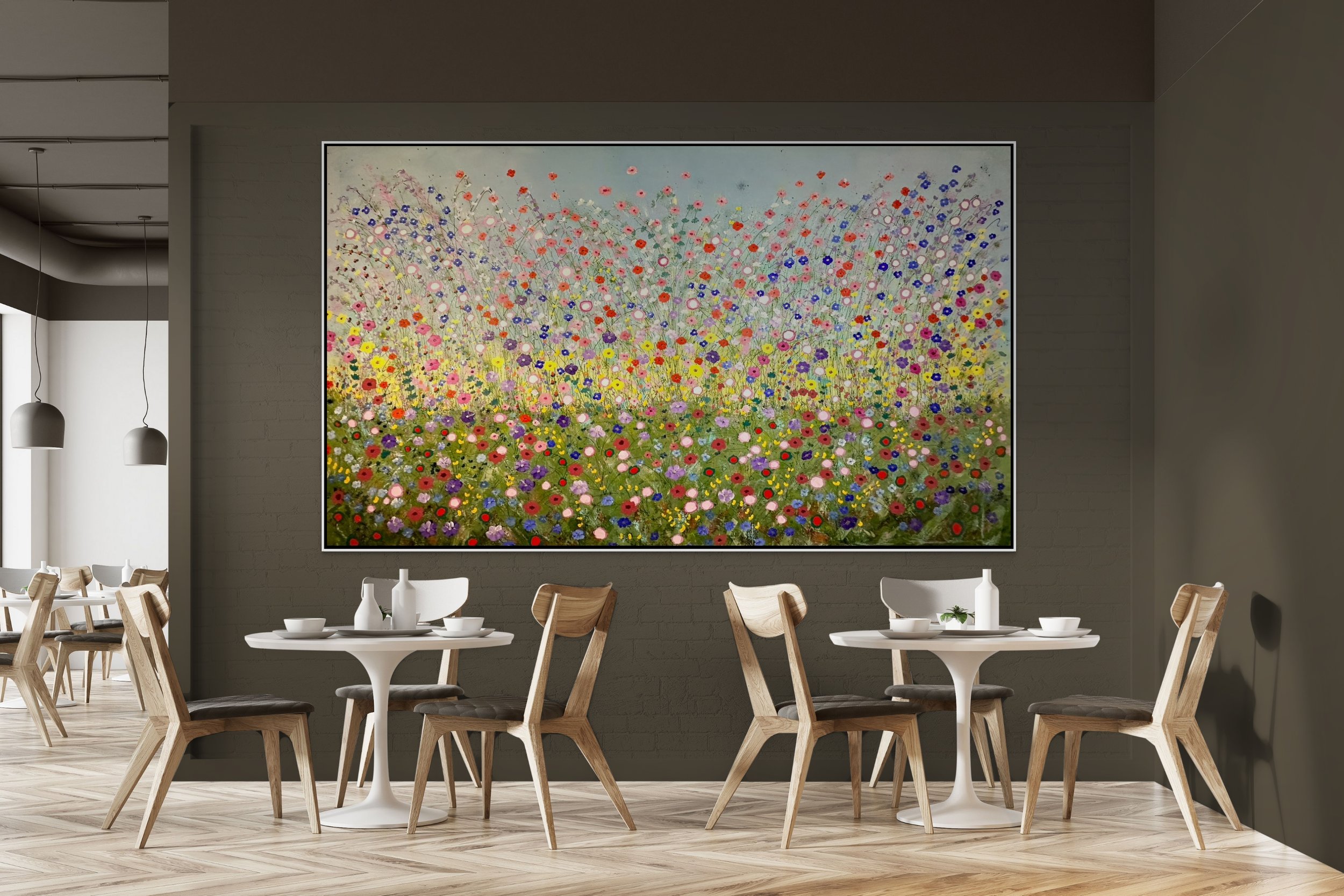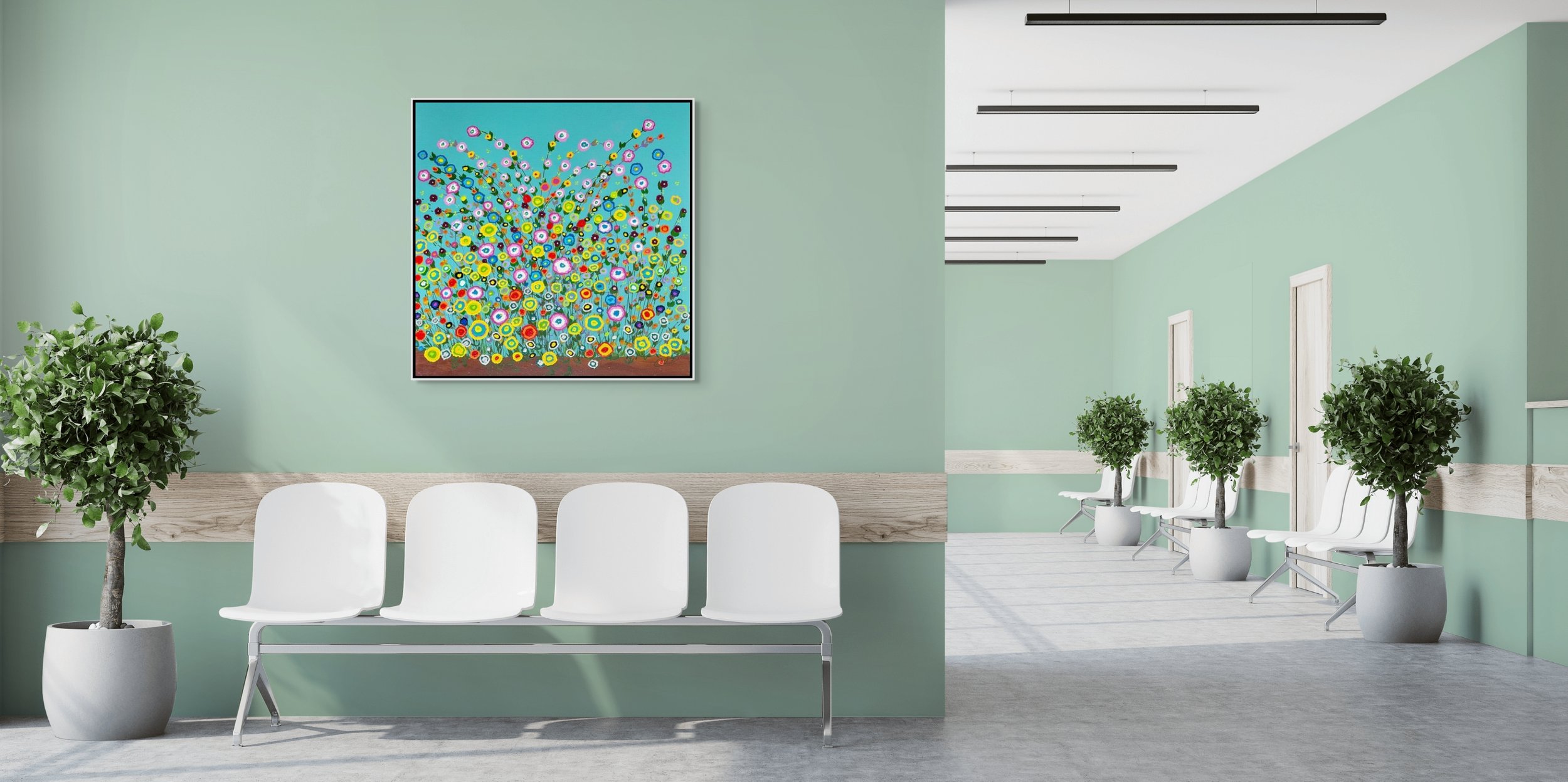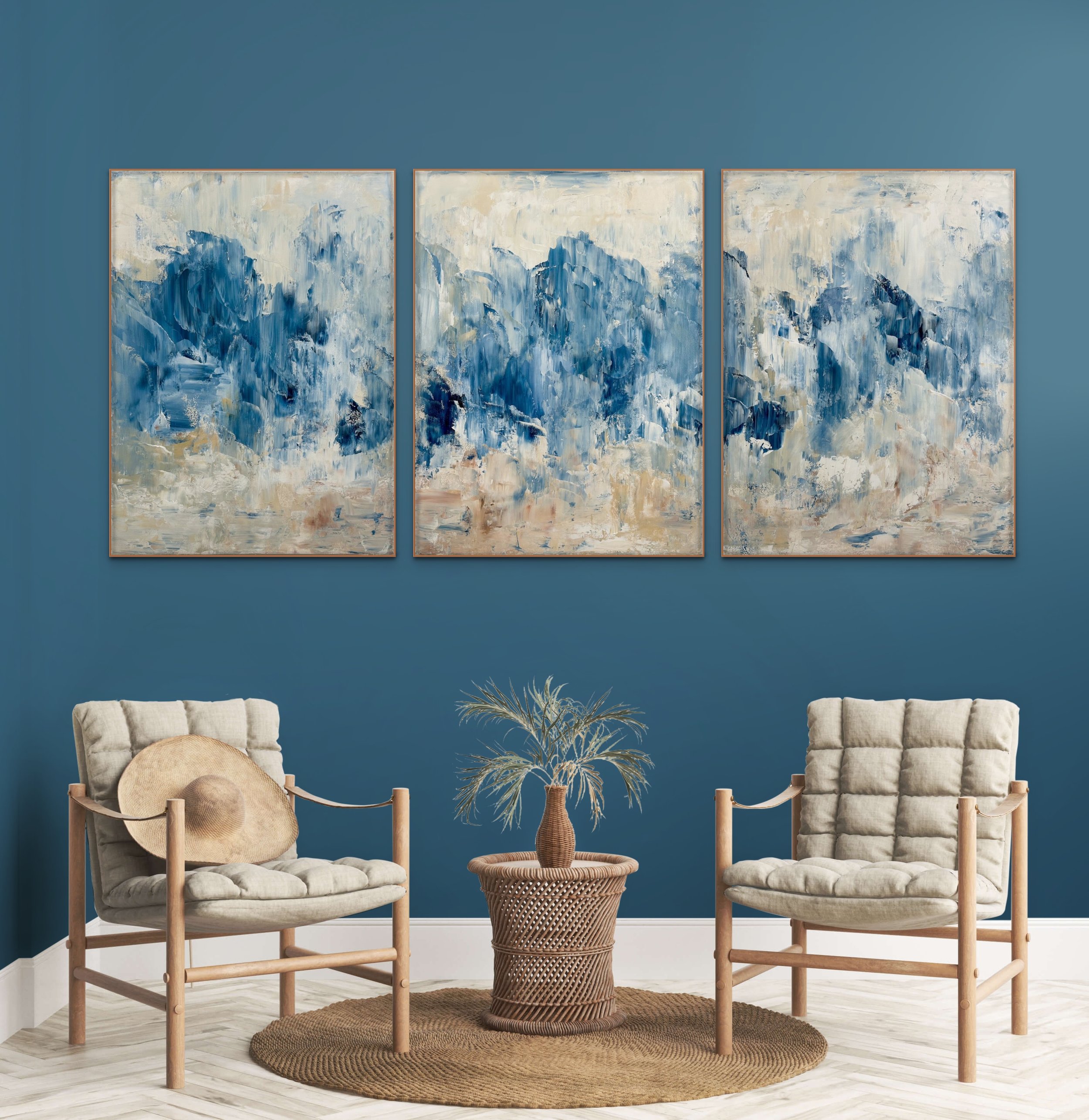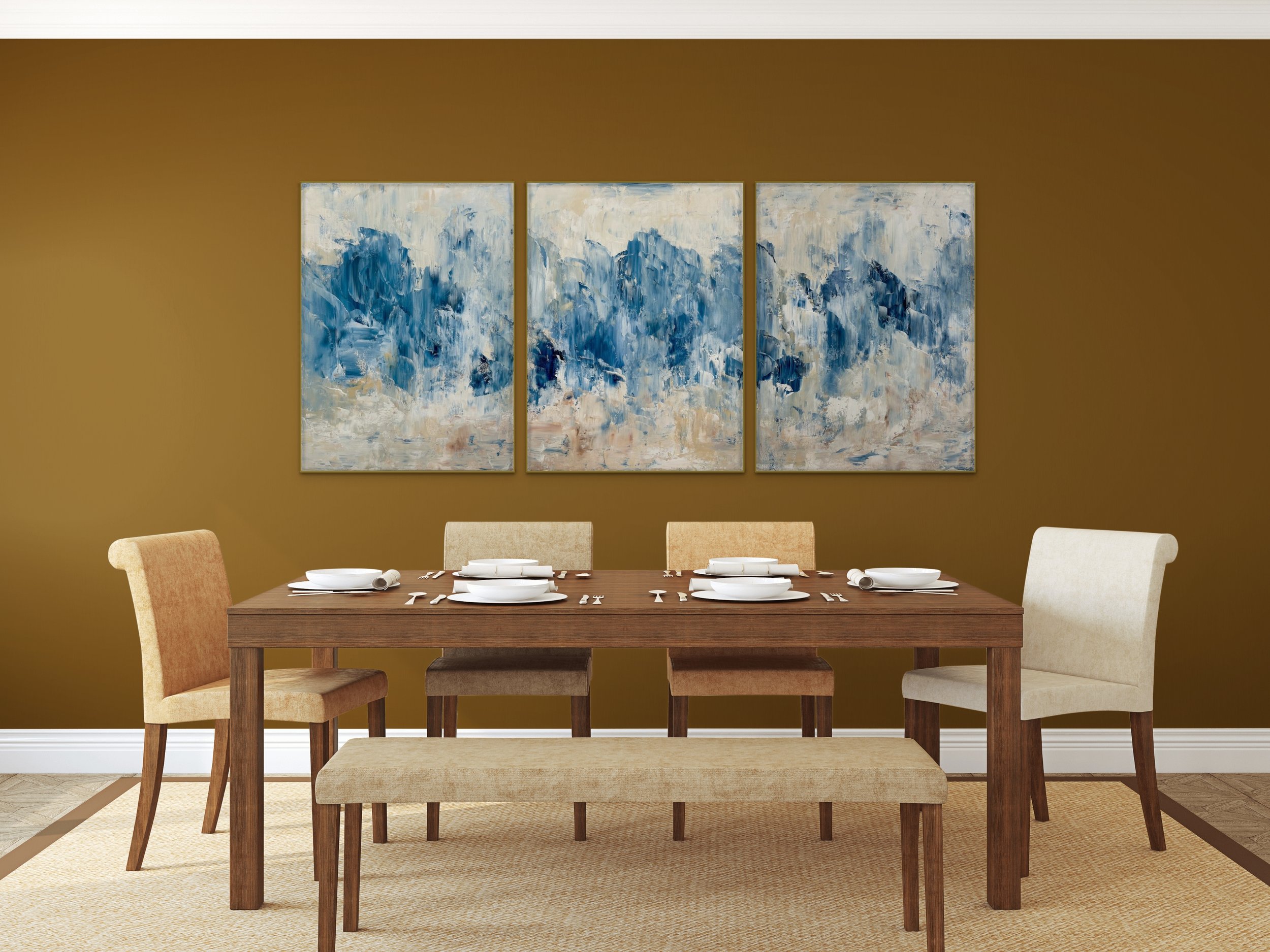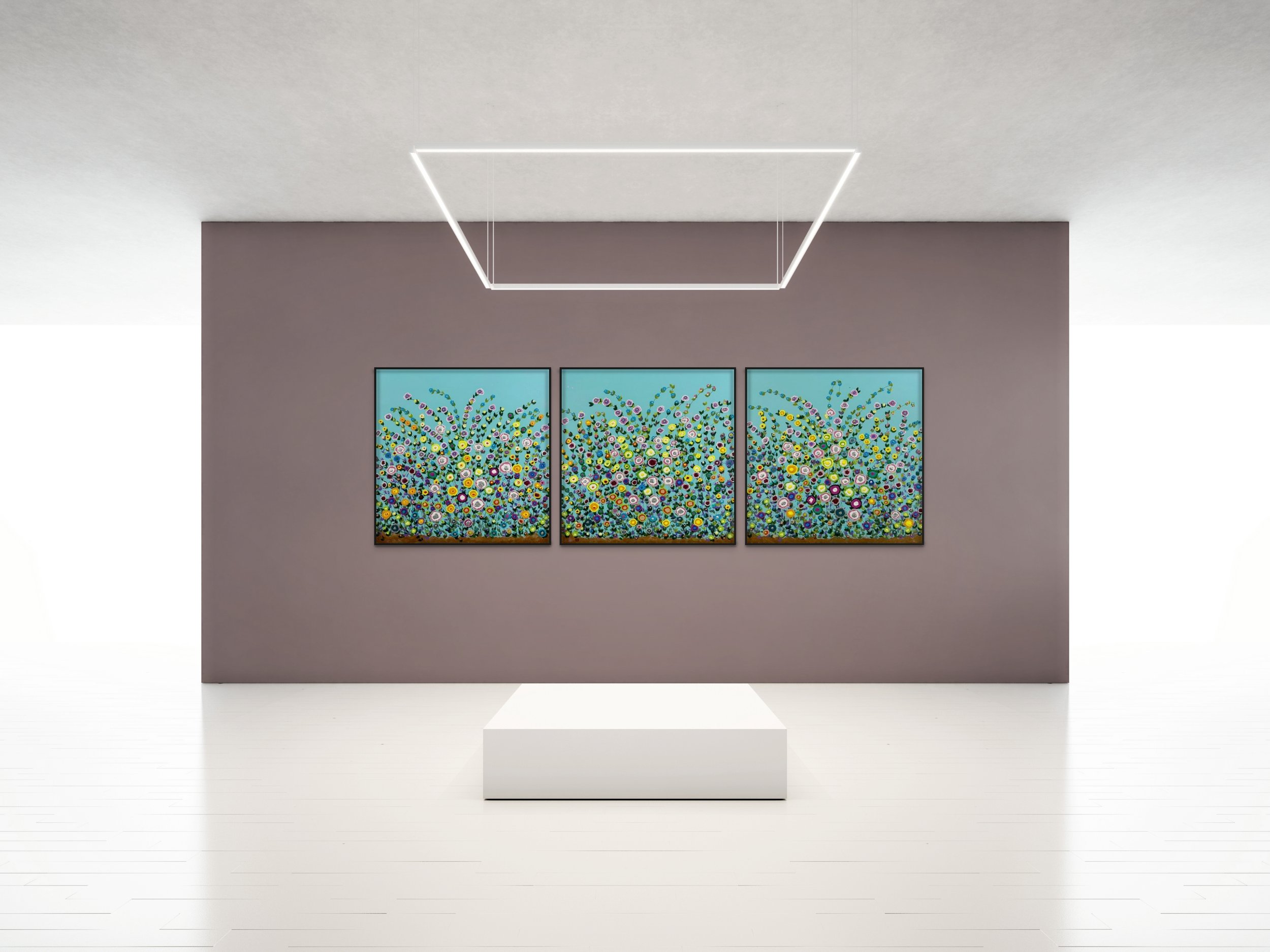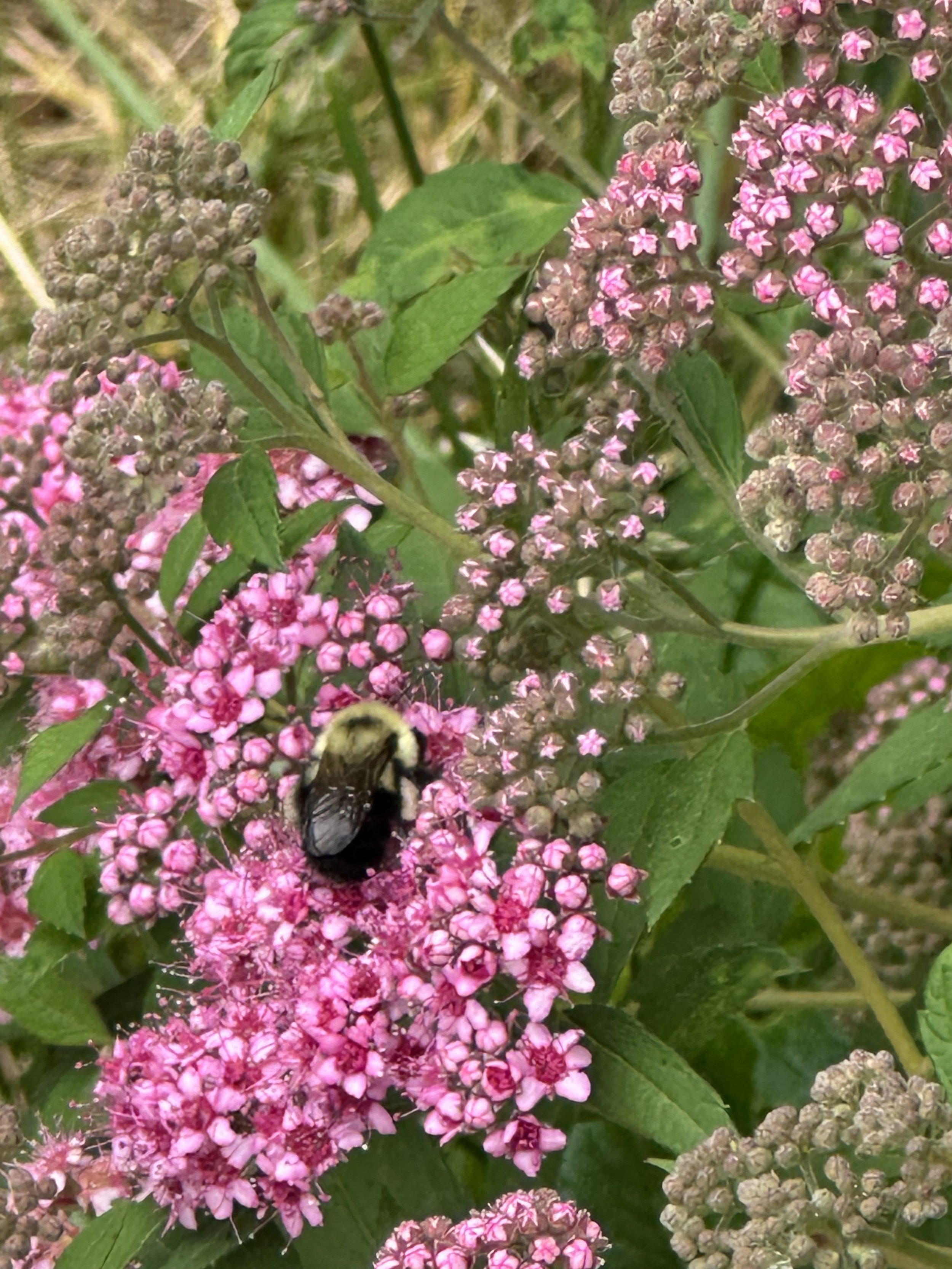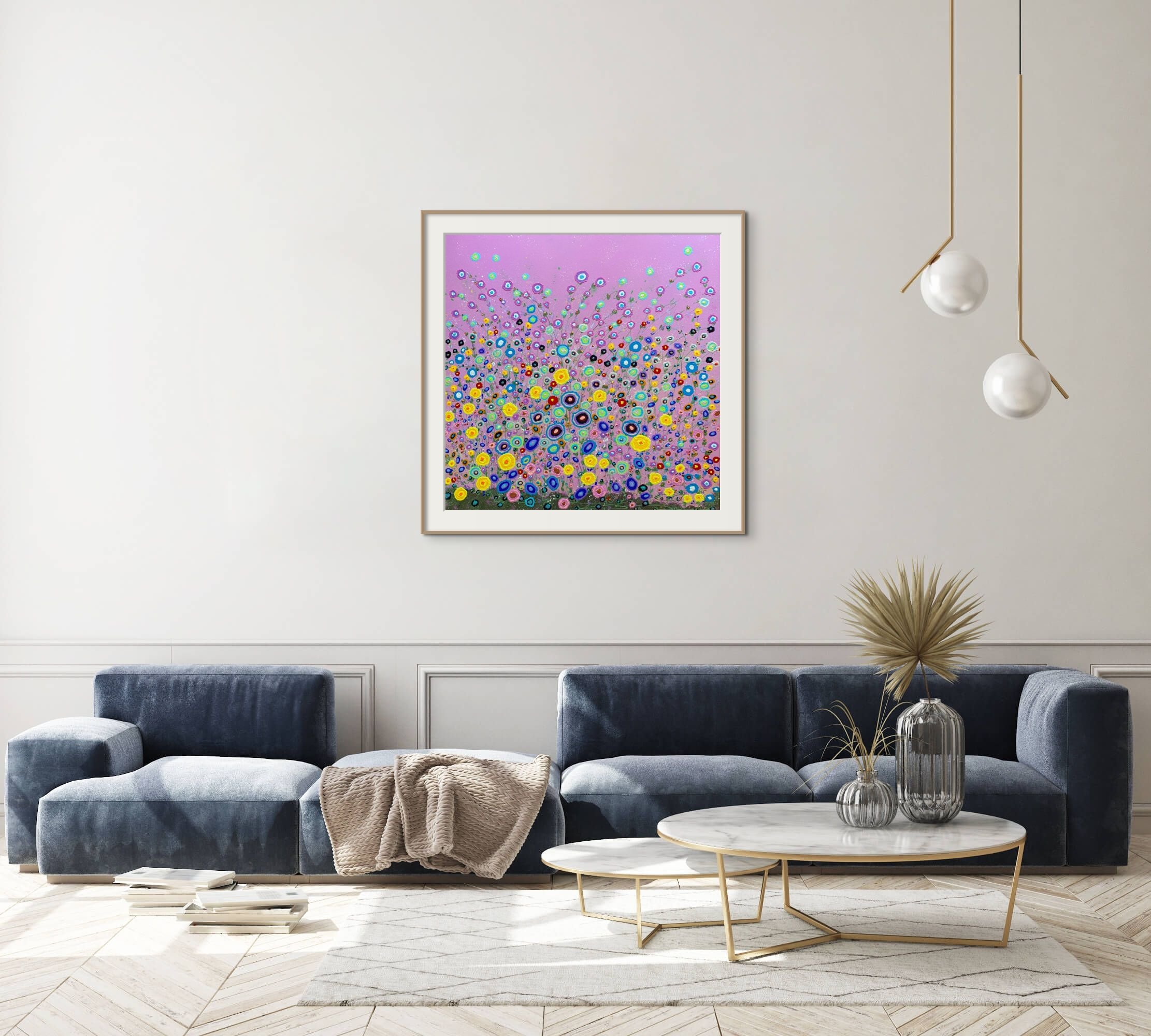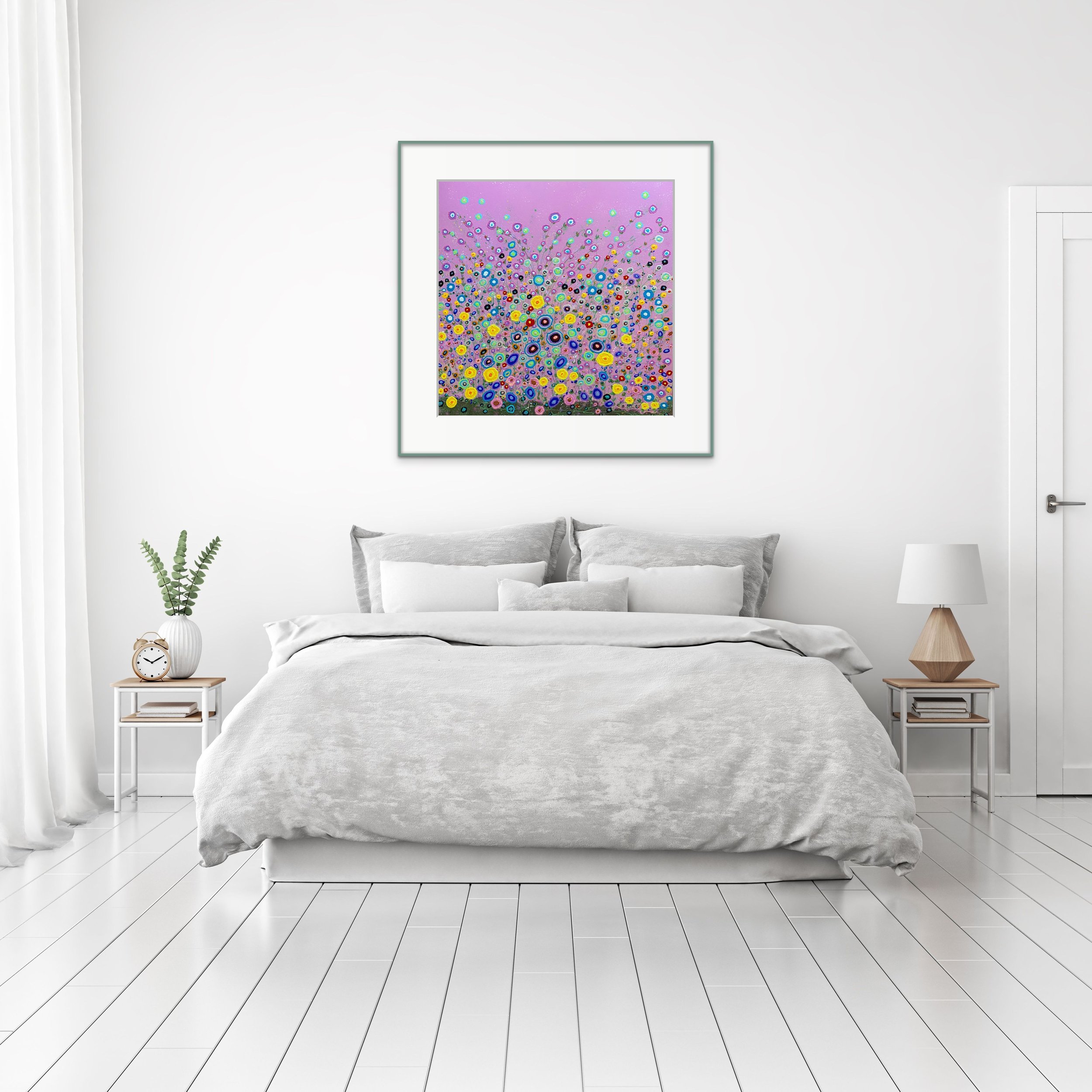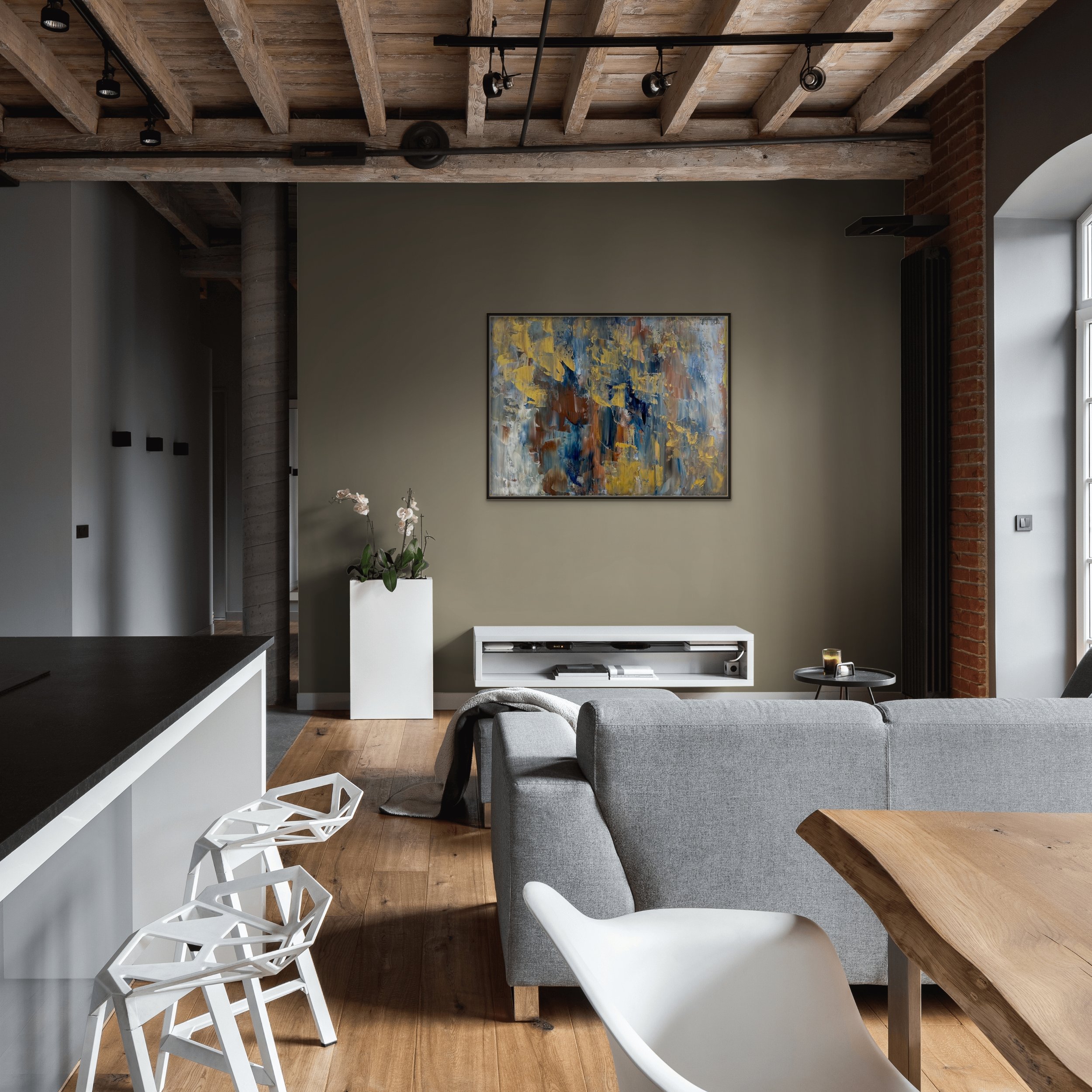Did You Know This About Art And Health?
Did you know many evidence-based design paintings focus on the impact the art has on the brain?
Did you know many evidence-based design paintings focus on the impact the art has on the brain?
The focus of this painting is not the art. The purpose of this piece is to create an uplifting mood of peace and happiness.
Wildflower Wonderland by Dorothea Sandra, EDAC (60”x96”)
The painting above is an evidence-based design floral that incorporates information from many medical and scientific research studies on the brain, art, and health.
The question should be, “Does this painting make viewers feel uplifted and happy?”
What matters most is that the piece triggers the brain to create chemicals that actually produce happy feelings.
Today we have fabulous technology to study the brain and see how art impacts it. In 2023, I was interviewed by the International + Mind Lab at the Center for Applied Neuroaesthetics, Pedersen Brain Science Institute at the Johns Hopkins University School of Medicine for my work creating evidence-based design art.
The principal investigator of the study I was in, Susan Magsamen, is a leader in this field and in her book, Your Brain on Art, How the Arts Transform Us, she writes: “New research, discoveries, and applications continue to mount. The sheer magnitude of this work is exceptional, and it promises to continue to accelerate. In the near future, as ever-more-sophisticated neuroaesthetic research becomes capable of measuring the effect of the arts on neural networks and those 600-plus mechanisms already identified, we will know more about how the arts affect us and how they can further benefit every aspect of our lives.” (p231)
During my interview with the Johns Hopkins University School Of Medicine team, I emphasized that while I am creating evidence-based design paintings, my primary focus is not on creating beautiful art.
My focus while I am painting is to use established evidence-based design guidelines and principles to create art that impacts the brain so happy chemicals (like dopamine) are created.
With today’s evidence-based design art, the question isn’t, “Do you like this?” The question is, “How does this painting make you feel?”
Take A Peek Inside My Book, 100 DAYS OF HAPPY HAPPY ART, EVIDENCE-BASED DESIGN.
Click the book cover to view.
Did You Know This About Our Brains And Art?
Did you know a growing body of research shows conclusively that our physical environments (rooms, buildings, walls, etc.) actually have an impact on our quality of life?
Did you know a growing body of research shows conclusively that our physical environments (rooms, buildings, walls, etc.) actually have an impact on our quality of life?
Evidence-based design has been defined as the process of basing design decisions about the built environment on credible research to achieve the best possible outcomes.
When inside built environments our brains get triggered by all kinds of things like color, lighting, texture, and especially art. In one study done on hospital waiting areas, physical and ambient properties influenced patient experiences. Areas associated with higher physical attractiveness reduced anxiety, were perceived to provide better quality of care, and were perceived to have shorter waiting times.
“Similarly, a waiting area with a nouveau (non-traditional) style was associated with lower self-reported stress and higher patient satisfaction than a traditional style.” (Improving the Patient Experience, California Healthcare Foundation)
Fun Fun Everywhere is a playful evidence-based design work of art. It’s a fun painting designed for attractiveness in a nouveau/non-traditional style.
Happy Together With Friends by Dorothea Sandra, EDAC
As I am creating this style of playful evidence-based art, there’s always the challenge of balance. One goal is to trigger the brain to create lots of feelings of fun and happiness without causing any stress. Another goal is to achieve high “distraction” levels of interest, again, without causing stress by overwhelming the viewer with too many details.
Especially when people are troubled or in pain, research studies show that happy art distractions will very positively impact the quality of human life.
For Happy Together With Friends, I was going for the moods of playfulness, happiness, and fun. I also wanted to add in a dash of ironic quirkiness with the hope of making someone—who just didn’t feel good or well—crack a smile.
I have a painting, similar to this one, in the cancer wing of a hospital. When coming out of the blood draw area and on the way to the infusion center, there it is.
Cancer patients, family members, and staff tell me all the time just how much they enjoy that painting. I’ve always suspected it’s the ironic quirkiness built into the painting’s many layers that triggers the brain to create happy emotions, especially at solemn times like this.
These paintings were created—not for their realism or beauty—but to trigger the brain to create the feelings of fun, happiness, and joy.
Take a look inside my book, 100 Days Of Happy Happy Art, Evidence-Based Design
There’s even a chapter on neuroscience and art.
Anatomy Of An Art Sale
One thing I do as an online art business owner is take responsibility for giving clients a super easy, stress-free buying experience.
My evidence-based design art business is not without its challenges. I live in a clean, safe, nature-filled part of Northern Michigan. It’s a fabulous place to create evidence-based design art, but it’s SUPER REMOTE.
I sell online at https://dorotheasandraart.com and https://singulart.com/en/artist/dorothea-sandra-36937 and I’m galleries in the U.S., but I also like to sell locally. I’m fortunate that about 40 miles away there’s a town called Alpena, Michigan. I really enjoy Alpena and call it my “authentic” arts town because it has not yet become too commercialized. It’s busy with so many downtown festivals and so many summertime visitors from all over the world. In 2024, Viking Cruise Ships on their Great Lakes Tours will stop 26 times in Alpena’s harbor.
Recently, at the Art In The Loft gallery in downtown Alpena, I sold a 6’x9’ painting called Wildflower Wonderland.
A cruise ship visitor from Kansas City, Missouri fell in love with this evidence-based design work of art. She really wanted to buy it but had no idea how to purchase it (while on a cruise) and then get it up on the wall in her home. The staff at Art In The Loft told her I shipped internationally and nationally and gave her my art studio number. When she called, I assured her I would take her through the sale step-by-step.
(Image source: Alpena News)
After she made the purchase, the first thing I did was have the painting taken off the gallery wall, wrapped back up, and transported back to my studio. In the studio, I then examined the painting and rewrapped it in acid-free glassine paper (which protects against moisture, air, and grease).
I gave the painting additional protection by wrapping it in bubble wrap and had a shipping crate prepared.
Another Dorothea Sandra work of art ready for UPS shipping pick up.
While this was going on, I got on the phone and called framing shops in Kansas City, Missouri to arrange for the painting to be stretched and attached to a wooden frame.
Why didn’t I stretch and frame the painting here in Michigan and then ship it to Missouri? If I had tried to ship a 6’x9’ framed painting, the cost would have been too expensive.
Finding the right stretching/frame shop for a client is one of the trickiest parts of the sale.
The first place I called—a well-known art chain store in Kansas City—wouldn’t stretch such a large painting. The second place I called—a framing store with corporate clients—at first said stretching a 6’x9’ wouldn’t be a problem and would only costs a couple hundred dollars, which is a good price for a stretch. The second time I called to confirm the sale, the manager told me he’d get back to me in 10 minutes. After waiting, I called him back an hour later and an employee told me he was busy talking to customers. He never did call me back. The third place I called—the Brookside Gallery on 114 W. 63rd Street in Kansas City—was fabulous. They were a tiny bit more expensive, but they could easily trim and stretch a 6’x9’. We decided to ship the painting directly to them, which would save the buyer any to-and-from transport headaches.
When I make arrangements like this for my buyers, I always look for extreme business competence and excellent customer care. The Brookside Gallery also agreed to connect my buyer with their local art transport company/wall installer.
One thing I do as an art business owner is take responsibility for giving clients an easy, stress-free buying experience.
I figure if I am taking the extra time to create evidence-based design art that triggers the brain to produce happiness chemicals, then I should also take the time to create buying experiences that also produce happiness chemicals in the brain.
In the end, my client who bought an evidence-based work of art while on a cruise, will have been taken care of every step of the way.
I told her, until the painting is installed exactly the way she wants it on her wall, we are in this together.
Experimenting With Art And Health
I’m an artist and innovator in the field of art and health, so I like to experiment a lot.
Recently ARTPLACER.com, an art placement company I really enjoy, added patient rooms to their excellent selection of mockup photos. Today my happy evidence-based design art hangs in so many different physical settings, but I have always told people I never considered it a good fit for the inside of a hospital patient’s room.
With ARTPLACER’S new mockup photos, here was my chance to really experiment within the inside of patient rooms, so I did.
When I create evidence-based design art, I think back to when I needed two major surgeries in different parts of my body in less than 30 days. Through this experience I realized there were so many different stages involved—such as the in-hospital pre-operation stage, the in-hospital post-operation stage, and the at-home longterm recovery stage. I also realized how my needs were different during each stage.
Right after surgery, while in my patient room, I felt that my entire body had been seriously assaulted and traumatized—and it had. The hospital, the staff, and my two doctors were all excellent, but that’s just what happens when a human body needs major surgical operations.
While inside my patient room, what I needed most was a total relief from any additional stimulation or trauma. Most of my evidence-based art is strategically and deliberately designed to not stress, but it is also designed to stimulate.
The trick—or I should say the skill—as an evidence-based design patient room artist is to create a work of art that is lovely according to the evidence-based design guidelines but is also one that does not cause too much brain stimulation. The art should be lovely without impact.
Placing different pieces of my art in ARTPLACER’S new hospital rooms, I was able to do some experimenting and here are some things I discovered.
Very much to my surprise, some of my florals did very well, even in a darker patient room. They were lovely and uplifting and fit comfortably in this room without creating too much stimulation to the brain.
I was even more surprised to see that even my bolder evidence-based design florals succeeded. They clearly delivered happiness and cheer without causing any stress or trauma.
Here are some of my other evidence-based design paintings that I thought might just work inside a patient room. I have always felt that my ideal hospital patient room should have carefully selected works of real art on the wall. Bland, boring, stereotypical designs actually frighten me. It’s as if this art makes a kind of heart monitor flatline sound. For me, art is hyper visual but it’s also always full of music and sound.








Did You Know This About Our Brains And Art?
Did you know a growing body of research shows conclusively that our physical environments (rooms, buildings, walls, etc.) actually have an impact on our quality of life?
Did you know a growing body of research shows conclusively that our physical environments (rooms, buildings, walls, etc.) actually have an impact on our quality of life?
Evidence-based design has been defined as the process of basing design decisions about the built environment on credible research to achieve the best possible outcomes.
When inside built environments our brains get triggered by all kinds of things like color, lighting, texture, and especially art. In one study done on hospital waiting areas, physical and ambient properties influenced patient experiences. Areas associated with higher physical attractiveness reduced anxiety, were perceived to provide better quality of care, and were perceived to have shorter waiting times.
“Similarly, a waiting area with a nouveau (non-traditional) style was associated with lower self-reported stress and higher patient satisfaction than a traditional style.” (Improving the Patient Experience, California Healthcare Foundation)
Fun Fun Everywhere is a playful evidence-based design work of art. It’s a fun painting designed for attractiveness in a nouveau/non-traditional style.
Happy Together With Friends by Dorothea Sandra, EDAC
As I am creating this style of playful evidence-based art, there’s always the challenge of balance. One goal is to trigger the brain to create lots of feelings of fun and happiness without causing any stress. Another goal is to achieve high “distraction” levels of interest, again, without causing stress by overwhelming the viewer with too many details.
Especially when people are troubled or in pain, research studies show that happy art distractions will very positively impact the quality of human life.
For Happy Together With Friends, I was going for the moods of playfulness, happiness, and fun. I also wanted to add in a dash of ironic quirkiness with the hope of making someone—who just didn’t feel good or well—crack a smile.
I have a painting, similar to this one, in the cancer wing of a hospital. When coming out of the blood draw area and on the way to the infusion center, there it is.
Cancer patients, family members, and staff tell me all the time just how much they enjoy that painting. I’ve always suspected it’s the ironic quirkiness built into the painting’s many layers that triggers the brain to create happy emotions, especially at solemn times like this.
These paintings were created—not for their realism or beauty—but to trigger the brain to create the feelings of fun, happiness, and joy.
Take a look inside my new book, 100 Days Of Happy Happy Art, Evidence-Based Design
There’s even a chapter on neuroscience and art.
Did You Know This About Art And Health?
Did you know many evidence-based design paintings focus on the impact the art has on the brain?
Did you know many evidence-based design paintings focus on the impact the art has on the brain?
The focus of this painting is not the art. The purpose of this piece is to create an uplifting mood of peace and happiness.
Peace And Happiness by Dorothea Sandra, EDAC (60”x96”)
The painting above is an evidence-based design floral that incorporates information from many medical and scientific research studies on the brain, art, and health.
The question should be, “Does this painting make viewers feel uplifted and happy?”
What matters most is that the piece triggers the brain to create chemicals that actually produce happy feelings.
Today we have fabulous technology to study the brain and see how art impacts it. I was recently interviewed by the International + Mind Lab at the Center for Applied Neuroaesthetics, Pedersen Brain Science Institute at the Johns Hopkins University School of Medicine for my work creating evidence-based design art.
The principal investigator of the study I was in, Susan Magsamen, is a leader in this field and in her book, Your Brain on Art, How the Arts Transform Us, she writes: “New research, discoveries, and applications continue to mount. The sheer magnitude of this work is exceptional, and it promises to continue to accelerate. In the near future, as ever-more-sophisticated neuroaesthetic research becomes capable of measuring the effect of the arts on neural networks and those 600-plus mechanisms already identified, we will know more about how the arts affect us and how they can further benefit every aspect of our lives.” (p231)
During my interview with the Johns Hopkins School Of Medicine team, I emphasized that while I am creating evidence-based design paintings, my primary focus is not on creating beautiful art.
My focus while I am painting is to use established evidence-based design guidelines and principles to create art that impacts the brain so happy chemicals (like dopamine) are created.
With today’s evidence-based design art, the question isn’t, “Do you like this?” The question is, “How does this painting make you feel?”
Take A Peek Inside My New Book, 100 DAYS OF HAPPY HAPPY ART, EVIDENCE-BASED DESIGN.
Click the book cover to view.
Did You Know This About Health And Art?
Did you know that Evidence-Based Design nature scenes are restorative?
Did you know that Evidence-Based Design nature scenes are restorative?
With all the talk today about Evidence-Based Design—what is it?
Evidence-Based Design is a field of study that emphasizes using credible medical and scientific evidence to influence design. Evidence-Based Design uses ideas from environmental psychology, architecture, neuroscience, behavioral economics, and more.
According to Ulrich and Gilpin, research suggests that nature art, or art with views or representations of nature will promote restoration if it contains—
calm or slowly moving water
verdant foliage
flowers
spatial openness
park-like settings or Savannah-like properties
Over the years, I have tried to create location appropriate art using these (and other) evidence-based design principles and guidelines.
Here are three paintings where the backgrounds are of a stretch of beach on Highway 23 in Northern Michigan. (Local scenes are also favored in evidence-based design.) I’ve taken some criticism over the years for not painting with enough tradition and realism. Even though I am a natural-born abstract artist who also creates evidence-based design art because it has the potential to help restore human health and happiness, I don’t mind. The huge pink clouds next to the pretty blue skies are in this first painting because that’s just how amazing the skies can be in this geographic location. (evidence-based design guideline: local scenery)
Print of Morning Majesty
Also, keeping in line with Ulrich and Gilpin’s evidence-based guideline of calm or slowly moving water, Lake Huron is amazingly still on most warm weather days. I deliberately keep my brushstrokes long and flowing. This creates the calmness, which creates a restorative/de-stressing effect. For water high-interest but not water high-focus, I blend the paint into a variety of colors.
People are often so surprised when they arrive at this location on Highway 23 because—from the horizon line to the shore—the water is often a dark blue, then medium blue, then a lighter blue, then an aqua color. The aqua color comes from an abundance of limestone. (evidence-based design: calm or slowly moving water)
Print of Beautiful And Happy
Print of Lake Huron Lovely #2
In many of these paintings, I also introduce the evidence-based guidelines of flowers and verdant foliage because people in this area love flowers. (evidence-based design: flowers and verdant foliage)
In the warmer months, many towns in the Great Lakes region burst with downtown flower festivals, downtown flower baskets, and flower sales.
This area, already a water lovers destination, also becomes a super happy flower lovers paradise.
This painting, Hope’s Sunshine, is a view of Lake Huron from flower-beautiful Mackinac Island
Take a peek inside my new book, 100 Days Of Happy Happy Art, Evidence-Based Design
There’s even a chapter on neuroscience and art.
Did You Know This About Health And Art?
Did you know there is now scientific evidence showing that art heals?
Did you know there is now scientific evidence that art heals?
That’s right. There is now clear and convincing medical evidence that viewing nature inspired compositions plays a key role in creating healing environments for us.
Certain types of art even have the power to—
reduce stress
lower blood pressure
reduce the need for pain medication
be a positive distraction
and more
As an evidence-based design (EDAC) certified artist, I like to read scientific and medical study findings and translate them into works of art.
One way I do this is through my floral designs. Each painting in this category is deliberately and strategically designed to meet one or more evidence-based design standards and guidelines.
My goal for these florals is never to create just a pretty work of art. That’s a given.
My goal is to create art that triggers the brain to create uplifting feelings of happiness and joy. The reaction I look for is not, “Oh, that’s pretty!” The reaction I want to hear as an evidence-based design artist is, “Yes, there’s something about this painting that makes me feel good as I look at it.”
Soft and simple, this evidence-based design sold as soon as it was put on display.
This evidence-based design also sold as soon as it was put on display.
Different aspects of these paintings were considered before painting. Which background color would be upbeat? How should the stems form to show joy and happiness? Where would the dividing lines be between the composition’s interest levels and stress levels? How would fun and happiness be communicated throughout the work of art?
Joy by Dorothea Sandra





Take a peek at my new book, 100 Days Of Happy Happy Art, Evidence-Based Design.
There’s even a chapter on neuroscience and art.
Creating Joy In Abstract Art
Is it possible to create a modern work of abstract art that triggers the brain to create feelings of joy?
Is it possible to create a modern work of abstract art that triggers the brain to create feelings of joy?
Personally, I’m convinced of it. What is my reasoning? Buyers tell me all the time how happy my art actually makes them feel.
What’s the secret? Is it super talent or artistic genius or is it training and certification in Evidence-Based Design? I believe it’s a combination of talent and training. Based on established medical and scientific research, I know there are relationships between design factors and healthcare outcomes, especially when people view nature. I create and sell an abundance of nature scenes (see my websites dorotheasandra.com and the landscape category of thewonderfulworldofdorotheasandraart.com) but I also love to create and believe in abstract art as health and happiness sources.
I’m a member of The Society of Experimental Artists and also hold the EDAC (Evidence-Based Design Accreditation and Certification) designation, so I have a keen interest in trying new and different ways to create art.
Joyful Movements by Dorothea Sandra
In this triptych titled Joyful Movements, I experimented with using acceptable “evidence-based design” colors (soft and gentle) and combining them with “the abstract essences” of nature’s wind, rocks, sand, and water. Solely as an abstract work of art, Joyful Movements holds it own. The colors are amazingly beautiful and the palette knife movements create deep interest and intrigue.
My goal when designing this was to see if I could connect “evidence-based design” guidelines with “abstract art” techniques, so I stuck with “the essences” of nature—rather than identifiable shapes—for the purpose of keeping the composition free of too much impact and stress. I wanted this piece to be beautiful, but I also wanted it to do more for us. I wanted it to be gentle and soothing and to remind of us of nature’s amazing healing powers.
I wanted the brains of viewers to be reminded of nature’s water and sand and wind and rocks rather than to be touched (impacted) by them. Many of today’s neuroscientists have conducted studies on our brains and art. Professor Semir Zeki, a neurobiologist from the University of London, discovered in his studies: “When a person views art they find beautiful, it triggers an immediate release of dopamine into the brain—a chemical related to feelings of love, pleasure, and desire.”
Pierre Lemarquis, a French neuroscientist, concluded: “Art of all kinds acts on our brains in a multi-faceted dynamic way. Neural networks are formed to achieve heightened complex states of connectivity. Art can sculpt and even caress our brains.”
My overall desire for Joyful Movements was to achieve a work of art with moving nature essences that evoked in us feelings of happiness and healing.
Although this painting was created after 100 Days Of Happy Happy Art, Evidence-Based Design was published, here is an excerpt about designing with water from my book. There’s more to just painting water and nature elements when it comes to meeting all the evidence-based design standards.
For me to create “happy” art, I remember that the medical/scientific “evidence” matters.
“In evidence-based art, compositions with water should provide healing. Calm water scenes are preferred, while gushing rapids or crashing ocean waves should be avoided. Even a trickling water fountain might create negative experiences for people with full or nonfunctioning bladders.” (Distinctive Art Source, “Healthcare Art Bloopers,” 2023)
Creating Joy In Abstract Art
Is it possible to create a modern work of abstract art that triggers the brain to create feelings of joy?
Is it possible to create a modern work of abstract art that triggers the brain to create feelings of joy?
Personally, I’m convinced of it. What is my reasoning? People tell me all the time how happy my art actually makes them feel.
What’s the secret? Is it super talent or artistic genius or is it training and certification in Evidence-Based Design? I believe it’s a combination of talent and training. Based on established medical and scientific research, I know there are relationships between design factors and healthcare outcomes, especially when people view nature. I create and sell an abundance of nature scenes (see my websites dorotheasandra.com and the landscape category of thewonderfulworldofdorotheasandraart.com) but I also love to create and believe in abstract art as health and happiness sources.
I’m a member of The Society of Experimental Artists and also hold the EDAC (Evidence-Based Design Accreditation and Certification) designation, so I have a keen interest in trying new and different ways to create art.
Joyful Movements by Dorothea Sandra
In this triptych titled Joyful Movements, I experimented with using acceptable “evidence-based design” colors (soft and gentle) and combining them with “the abstract essences” of nature’s wind, rocks, sand, and water. Solely as an abstract work of art, Joyful Movements holds it own. The colors are amazingly beautiful and the palette knife movements create deep interest and intrigue.
My goal when designing this was to see if I could connect “evidence-based design” guidelines with “abstract art” techniques, so I stuck with “the essences” of nature—rather than identifiable shapes—for the purpose of keeping the composition free of too much impact and stress. I wanted this piece to be beautiful, but I also wanted it to do more for us. I wanted it to be gentle and soothing and to remind of us of nature’s amazing healing powers.
I wanted the brains of viewers to be reminded of nature’s water and sand and wind and rocks rather than to be touched (impacted) by them. Many of today’s neuroscientists have conducted studies on our brains and art. Professor Semir Zeki, a neurobiologist from the University of London, discovered in his studies: “When a person views art they find beautiful, it triggers an immediate release of dopamine into the brain—a chemical related to feelings of love, pleasure, and desire.”
Pierre Lemarquis, a French neuroscientist, concluded: “Art of all kinds acts on our brains in a multi-faceted dynamic way. Neural networks are formed to achieve heightened complex states of connectivity. Art can sculpt and even caress our brains.”
My overall desire for Joyful Movements was to achieve a work of art with moving nature essences that evoked in us feelings of happiness and healing.
Although this painting was created after 100 Days Of Happy Happy Art, Evidence-Based Design was published, here is an excerpt about designing with water from my book.
“In evidence-based art, compositions with water should provide healing. Calm water scenes are preferred, while gushing rapids or crashing ocean waves should be avoided. Even a trickling water fountain might create negative experiences for people with full or nonfunctioning bladders.” (Distinctive Art Source, “Healthcare Art Bloopers,” 2023)
Today’s Mood Busting Art
Is it possible to bust through a bad mood with art?
Garden Holiday by Dorothea Sandra, EDAC
As many of you know, we live in “interesting” times. So many people today are stressed or sad or deeply troubled by something or someone. I like to use my art to fight against this by creating credible pieces that bust through these moods and create upward movement feelings of happiness and hope and joy. Using well-researched guidelines, I like to reach inside the brain through art and help shift a negative mood into something positive.
From the 1960s until today, serious researchers with very serious studies…from different countries…from different multidisciplinary fields have converged to create a new field of art called Evidence-based Design. According to the National Library of Medicine at the National Institute of Health, “Evidence-based design is scientific analysis methodology that emphasizes the use of data acquired in order to influence the design process in hospitals. It measures the physical and psychological effects of the built environment on its users.”
Today, evidence-based design isn’t just for hospitals. It’s for all of us. It is for many of the places humans go. What is my role in all of this? A very small one—but I think an important one. Today my art hangs in hospitals, businesses, organizations, and homes. Using my artistic talents and evidence-based design training and certification—just as I did in this triptych art called Happy Garden—I very deliberately and very strategically create happy, happy art for today’s built environments.
People often ask me where I get my inspiration for this style of painting I call Bubble Art. These photos of flowers come from just two of my yards in Northern Michigan. I live in a super clean, healthy environment and inspiration always seems to be all around me—everywhere I seem to look. Nature is a truly powerful healer. When we can’t be out in it, putting art on our walls that captures nature’s fun and beauty often helps.
(I keep 100 percent pesticide-free yards with many bee and butterfly friendly plants. The bees this years are plentiful. I have even seen up to 8-10 bees on one bush.)
In a Garden Holiday, I used my evidence-based knowledge to select the cheerful background color. I painted the flowers in soil to give the artwork a rooted to our life-giving earth feel. Flowers and stems are never similar or boring in nature, so I gave this work an abundance of fun-filled stem twists and turns, pops full of flowery color, and many hints of humor.
If you would like to learn a bit more about evidence-based design and see how I applied it to my art, my new book, 100 Days Of Happy Happy Art, Evidence-Based Design, is available through Amazon.
Bubbling With Happy Smiles
Today’s art to make us smile.
Creating happiness is a gift, and I love to use my artistic talents to help others smile.
Bubbling With Happy Smiles by Dorothea Sandra
What Happens To Our Brains On Art?
The research results are in: according to The Telegraph in the United Kingdom, “Looking at a gorgeous painting, sculpture, or other artwork, increases blood flow to the brain by as much as 10 percent—the equivalent of looking at someone you love.”
According to professor Pierre Lemarquis, the French neuroscientist who wrote L’art Qui Guérit (Art That Heals) “art of all kinds acts on our brains in a multi-faceted, dynamic way. Neural networks are formed to achieve heightened, complex states of connectivity. Art can sculpt and even caress our brains.”
Isn’t This Exciting?
My goal was to create a work of art that would trigger our brains for fun and laughter and smiles. There’s enough reality in the soil to ground the painting, while the stems take off playfully up and down and around and side to side. The colors are bright and cheerful and full of dynamism and diversity.
So many people have told me this piece instantly busts through bad moods and makes them smile inside. Others have said the flowers communicate that one is perfectly beautiful even when super odd or different or not traditionally formed.
So much of my art is influenced by nature’s water movements and flowers. Here is Bubbling With Happy Smiles, as well as other pieces, on display at the Art In The Loft Gallery in Alpena, Michigan.
People often think of small northern towns as boring. This “authentic arts town” busts with summer activities. Festivals, art, music, water activities, cruise ships docking, amazing natural areas, wildlife, and truly friendly and fun (and open minded) people makes Alpena, Michigan a place I spend lots of time visiting. I’m in two galleries there, and I love it!
Here are some photos of one of the marinas and just one of the many colorful side alleys and back parking lots.





In such a fun and friendly “authentic” place, it’s so easy to get inspired to create happy art. Many of the paintings in my book, 100 Days Of Happy Happy Art, Evidence-Based Design, were influenced by this clean, healthy, and super beautiful area.
This book is not a marketing push. (There are no painting prices published.) It is visually pleasing, as well as an informative journey into a new art field based on science and medical studies called Evidence-based Design.
Creating Power And Beauty In Art
Powerful Beauty is an amazing artwork people love to see.
Powerful Beauty is an amazing piece that people just love to see.
At the opening reception for a summer gallery exhibit, I was standing in front of this painting while talking to a NYC handbag designer for two world-famous fashion brands (who also bought one of my paintings that evening) when a very tall, amazingly elegant woman brushed behind me and whispered, “I l-o-v-e this piece!”
What makes Powerful Beauty such a winner?
To begin with, it was strategically designed to arouse and grab and gently caress. It’s beauty was deliberate and intentional. I am above all else an abstract artist, but I also trained and got certified in evidence-based design. I support the idea of basing designs on actual medical and scientific studies for health and healing and, like the many tools and techniques I use as an artist, I don’t hesitate to use these evidence-based design rules and guidelines while creating even abstract art.
The goal for Powerful Beauty was to create something abstract and full of movement but also balanced, stable, and beautiful to view.
If you would like more information about an artist’s adventures with evidence-based design, check out the book 100 Days Of Happy Happy Art, Evidence-Based Design by Dorothea Sandra.
It’s not just an art book. There’s lots of really cool and thoughtful information in it like, “What Exactly Is The Definition Of Evidence-Based Design?” (Section 1.4) to “What Happens To Our Brains On Art?” (Section 3.1) and “What Is Neuroarts?” (Section 3.2).
So, where did I get the inspiration for this piece? My studio is located in a Great Lakes region surrounded by amazing bodies of water. Almost everywhere I go, I am surrounded by raw, authentic, super clean NATURE. At first sight, this area might look ordinary or just another stretch of beach with rocks and sand, but when you look deeper and capture “the essence” of what is happening all around, it’s truly amazing. There’s always some kind of power or beauty happening.
This painting also made an appearance in the July issue of the London Tatler magazine. It’s #23.
Welcome
Welcome to the wonderful world of Dorothea Sandra Art.
YOU HAVE ARRIVED AT THE WONDERFUL WORLD OF DOROTHEA SANDRA ART!
BLOG #1—From Death To Life
A number of years ago I got diagnosed with two potentially life-ending illnesses. I was surprised when most family, friends, and people I had known for years politely dumped me. Essentially, I was left on my own and alone (with the exception of one brother) to go off into the wilderness and die somewhere.
Well—not only did I not die—I ended up creating a super fun, happy, and absolutely amazing new life. Welcome to the wonderful world of Dorothea Sandra art. Today I’d like to share the power of abstract art and photos and excerpts from my new book 100 Days Of Happy Happy Art, Evidence-Based Design.
Power In Action by Dorothea Sandra
Power In Action is a bold abstract. It reflects the awesomeness and diversity of real power. Done mostly with palette knives, it has intense movement and edge, while still maintaining balance, beauty, and grace. I really like the gold touches. They are there to show that having an abundance of wealth is a fun thing.
I was trained as a child to paint in oil, but today I find super high quality professional-level acrylic paint to be so much more fun. I love the ease in which it goes on, and the colors can be truly amazing. In this painting you can see the influence of the late Roger William Curtis, the famous New England seascape artist. My earliest teachers were trained by him. I still remember wiggling my toes in the damp Gloucester sand while listening to the paint mixing instructions for creating sea spray, water depth, and ominous rocky shores.
In addition to my love of abstract art, I also wrote a book called 100 Days Of Happy Happy Art, Evidence-Based Design. My brush with death had opened my eyes to the importance art can have on the brain, which helps with health, healing, and happiness. I got trained and EDAC (evidence-based design) certified through the Center For Health Design, and it has been one happy artistic adventure after another ever since.
Did you know evidence-based designs use credible medical/scientific studies in their design guidelines? Here is Section 1.1 from my new book.
IS EVIDENCE-BASED DESIGN SOMETHING TOTALLY NEW?
“If you asked the sixth-century BCE Greeks of Epidaurus, they might take you to one of the most celebrated healing centers of the classical world—the Asclepieion hospital. In their hospital, patient rooms faced eastward. Why? It is believed the rooms were intuitively designed and placed toward the sun to promote healing.
Many centuries later, many movements from different countries came together in the 1970s to create a new field called Evidence-based Design.
Who are the people whose forces created this new discipline? Doctors, scientists, architects, interior designers, psychologists, sociologists, anthropologists, and many, many others.
DAY ONE of 100 DAYS OF HAPPY HAPPY ART
The Healing Window, 36”x48”
I’m known as many things in the art world—an artist of hope, an artist who modernizes traditional woodsy compositions, a New England trained artist, a Great Lakes artist, and a 21st century experimental artist.
As a 21st century experimental artist, I like bringing together totally new or different things. Bringing together today’s health, while also thinking of the ancient Greeks, Day One of 100 Days Of Happy Happy Art features a painting of a window view a patient might see from a hospital room.
This painting’s background is of Little Traverse Bay from the back parking lot of the McLaren Northern Hospital in Petoskey, Michigan.
As I composed my images, I imagined I was inside one of the McLaren Northern patient rooms looking out. The flowers are modern and cheerful and uplifting, but I wanted to honor the achievements of those before us by giving elements within the composition a more rough, ancient Greek Asclepieion feel to it.”













